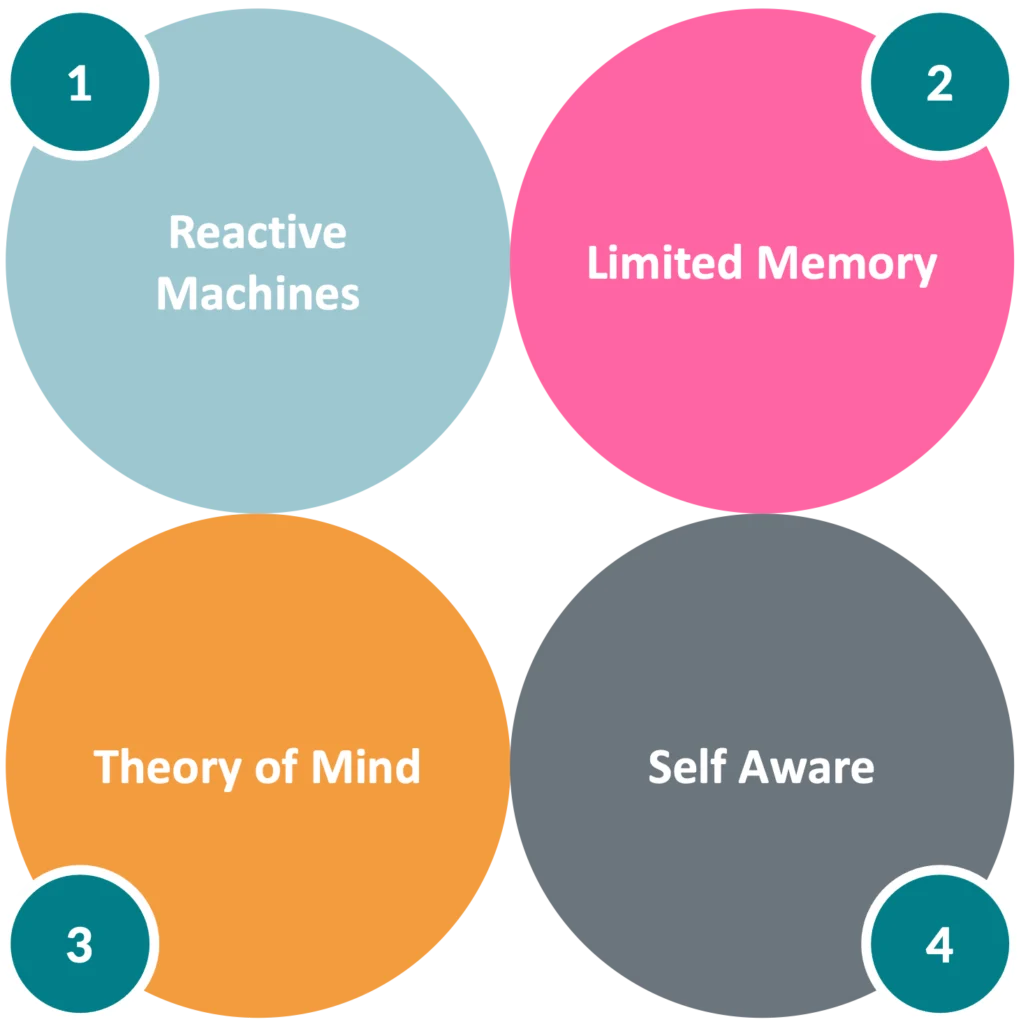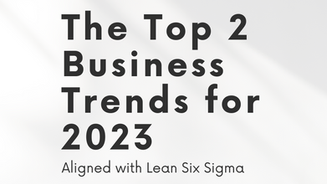According to Forbes, the top 2 business trends of 2023 are Sustainable, Resilient Operations and Balance between human workers and intelligent robots. As we contemplate these trends, we are fascinated by the connection and alignment with Lean Six Sigma. This is especially true as Lean Six Sigma evolves and strengthens in importance and relevance across the globe. Here we’ll look at these top 2 trends and explore their relationship with Lean Six Sigma.
Trend 1: Sustainable, resilient operations
Every organization must seek to eliminate or reduce the environmental costs of doing business. Decarbonizing the supply chain is a sensible place to start, but forward-thinking businesses are looking beyond the supply chain to improve sustainability across all business operations. And of course, sustainability is linked to resilience since resilience means being able to adapt and survive for the long term. Any business that ignores sustainability is unlikely to do well in this age of conscious consumption. – Forbes, Bernard Marr, Nov 1, 2021
Any organization that is truly focused on reducing the environmental costs of business must make decisions and allocate resources to accomplish significant changes. Real change will not happen without deliberate commitment and tangible actions. And once improvements are made, without resilience, any successes will quickly disappear. Resilience is an absolute must for any effort to succeed in the long term. In other words, if improvements are not adapted and sustained in the future, then what’s the point? Lean Six Sigma at its foundation, is designed to develop employees who are competent problem-solvers and to build resilient organizations that can swiftly and effectively react to rapid changes.
Implementing Lean Six Sigma in the organization will certainly provide the foundation and culture to become an environmentally sustainable organization. The 5 major elements of a Lean Six Sigma implementation include:
-
Leadership competence to develop and execute an organizational strategy to achieve goals. As leaders necessarily have diverse skills, a unified approach, such as Lean Six Sigma Sponsor, allows the organization to gain the greatest benefit from the diversity of skills while maintaining cohesive and aligned decision-making.
-
Daily problem-solving competence developed. Frontline employees are skilled at identifying opportunities and implementing solutions to problems aligned with the organizational strategy. As Lean Six Sigma Yellow Belts, the front line will be the first to recognize and address opportunities to eliminate waste and increase the efficient use of resources. We’ll never change our environmental impact until we change something we do every day. The secret of success is our ability to make a positive change in our daily routine.
-
Complex and cross-functional problem-solving. For those problems or opportunities that are more complex or that are cross-functional, the Lean Six Sigma Green Belt is competent in leading a team to solve the root causes of problems and implement sustainable solutions.
-
Validated Results. All improvements, no matter the size, should be verified to ensure that the change that was made actually resulted in an improvement. Creating real improvements means that we don’t just float ideas and then move on to the next trendy thing. It means that we are focused on real impact, one improvement at a time. The ability to measure improvement and hold ourselves accountable is one of the greatest benefits of a structured approach.
-
Sustain sustainability. It takes a lot of work, focus, and dedication to get to the point where significant benefits materialize. And without the ability to sustain the results, our efforts will only result in more wasted resources. A key foundational element of Lean Six Sigma is the competence to create sustainable solutions that will not disappear overnight. This means that the improvements become truly integrated into our ways of working…our bar has been raised and it will be continually monitored.
Any organization focused on improving the environmental costs of doing business will need to skillfully articulate its specific goals so that improvement efforts can be executed to achieve those goals. If a positive impact on the environment is important, knowing how to select the right improvements to go after and then seeing those come to fruition won’t just happen because your heart is in the right place. We need to ensure that our teams are well-equipped with the skills and support to see real results materialize. There’s a good reason why many people have started floating the idea of renaming Lean Six Sigma to things like “Green Six Sigma”, “Lean Ecology” and “Lean and Clean” just to name a few!
Trend 2: The balance between human workers and intelligent robots
We now have increasingly capable robots and artificial intelligence (AI) systems that can take on tasks that were previously done by humans. This leaves employers with some key questions: how do we find the balance between intelligent machines and human intelligence? What roles should be given over to machines? Which roles are best suited to humans? There’s no doubt that automation will affect every industry, so business leaders must prepare their organizations – and their people – for the changing nature of work. – Forbes, Bernard Marr, Nov 1, 2021
Studies show that the majority of people have a positive opinion about AI, holding the belief that Artificial Intelligence will have a profound and positive impact on their daily life in the next 3 to 5 years. Before we discuss how Lean Six Sigma is related to AI, let’s first review the 4 main types of AI:

1. The first type of AI is Reactive Machines, which are systems that react to the input. A few everyday examples are Netflix Recommendations, Spam filters, and games like online Chess. To increase the intelligence of a reactive machine, the logic that drives the machine must be improved and the input must be updated. In business, AI frees people from mundane tasks such as data entry or making simple, repetitive decisions. In large, complex applications (such as ERP or CRM tools), AI will become very important in making more accurate predictions and therefore better decision-making at the organizational level.
One of the greatest pitfalls that we have seen in businesses is the implementation of a large-scale solution, like Salesforce or NetSuite, without appropriate attention given to the setup, the logic, and the brains behind the tool. The tools can have amazing results, but the secret to their success is the ability of internal experts to define the logic that drives the tool. Implementing a new system of any kind requires building logic. And in most organizations, the unintended consequences are slowed productivity, worsening quality, and underestimation of costs and time. And without skilled application of logic, the longevity and scalability of the solution are minimized.
A competent Lean Six Sigma Green Belt or Black Belt has the skill to define and perfect logic to ensure the peak performance of a tool and therefore the people who work in the process. Whether that tool is manual or automated, the same principle applies. This is where we see a great difference between a Project Manager (who manages the tasks associated with a major implementation) and an experienced Lean Six Sigma practitioner, who will make strategic decisions, identify and resolve problems and design highly effective and efficient ways of working.
2. The second type of AI is Limited Memory, which focuses on prediction by using memory to learn and improve its responses. In a way, this is all about understanding cause and effect. This is a central focus of Lean Six Sigma and is evident in all areas of problem-solving whether it’s the daily problem-solving of the Yellow Belts, Visual Performance Management, or the complex data analysis performed by Green and Black Belts.
The more we empower the people in our organizations with the competence to perform these analyses, the better we will be able to increase the value and contribution of Limited Memory AI as the logic for these intelligent machines has to come from somewhere.
3. The third type of AI is the Theory of Mind. At this point, the Theory of Mind is well, still a theory. This type of AI understands and responds to the needs of others. For example, if you say, “Hey Google!” or “Alexa!” in an angry tone, your tone will activate a different response than if your voice was perceived as normal. And there’s a reason that this technology isn’t quite ready yet. One of the biggest gaps that we see in process improvement is the competence to address the people side of change. For many, technical skills are easier to learn and apply than less tangible human skills.
Certified Green Belts learn skills such as Stakeholder Management, Stakeholder Communication, Collaboration, and Team Skills which are all key aspects of understanding others. Black Belts and Purple Belts (Change Leaders) have a deeper understanding and level of competence to lead and develop others through major changes and challenges. These are skills that are not typically known or consistently practiced in most organizations. And, before we can advance to the automation of humanistic qualities in machines, we’ll need to get better at understanding and responding to the needs of others all on our own.
4. The fourth type of AI is Self-Awareness. This level of AI is expected to land sometime in the distant future. However, this is a great way to help us to see where our organizations should be working on the competence of their people. We’ve seen a big trend in new titles like Chief People Officer, Chief Happiness Officer, Chief Hearts & Meaning Officer, and many more like this. Being self-aware means that we understand our strengths and weaknesses and we understand the impact that we have on those around us.
As organizational improvement professionals, we have seen with our own eyes, the amazing impact that structured problem-solving and process improvement can have on employee engagement and overall joy at work. A strong leadership foundation that provides a clear vision aligned with specific goals, powered by employees who have been developed and allowed to create a better workplace is the best way to improve happiness, hearts, and meaning. Joy at work doesn’t come from posters, awards, or team-building events.
The difference between a technical Black Belt (in other words, someone who knows how to operate statistical software) and a truly effective and competent Black Belt, is self-awareness and the ability to develop others; the ability to recognize and build upon the strengths and weaknesses of a diverse group of people to bring out the absolute best performance. And THAT is what gets people doing great work and feeling great about the work that they do.
The evolution of AI is in so many ways tightly aligned to the evolution of Lean Six Sigma and it’s a welcome addition to the toolkit. And while we are awaiting the increasing competence of the machine world, let’s continue increasing the competence of our people in the 3-D world!
Learn more about Lean Six Sigma with a quick and easy White Belt Certification!









